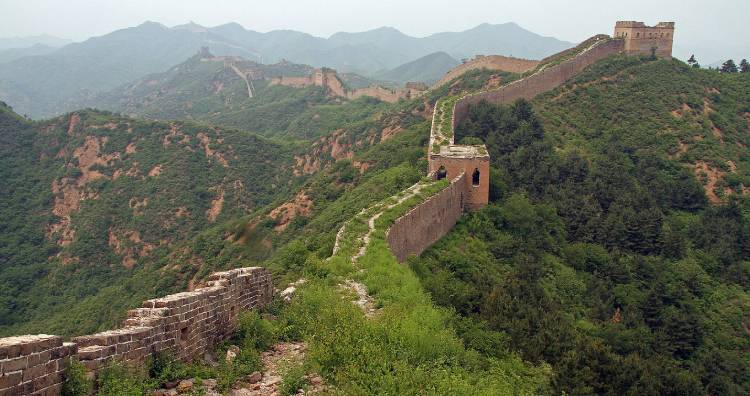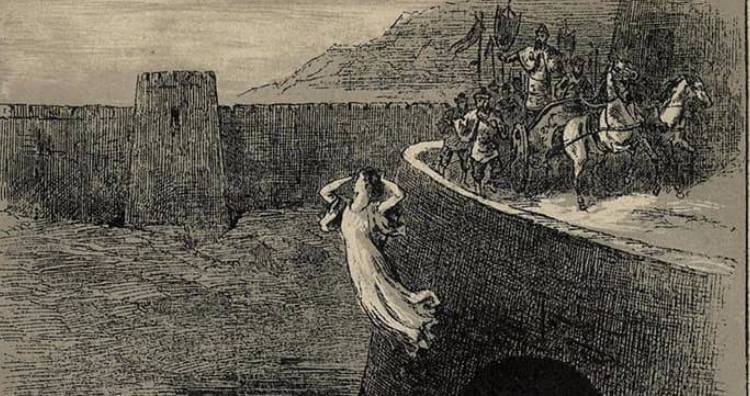25 Intriguing Facts About the Great Wall of China
13 Shrines on the Great Wall give tribute to figures from Chinese history.
The Great Wall has a lining of shrines and tributes dedicated to the Chinese figures from history. A third-century Chinese general, Guan Yu, who served during the Han Dynasty, has temples on the Wall dedicated to him. The Wall has various points which pay homage to Tiānwáng, the Four Heavenly Kings of Buddhism. (source)
14 The Northern Segment of the Great Wall was not built for war but to monitor civilian movement.
When the 460-mile Northern Line of the Great Wall was fully mapped by the researchers, they found that the northern segment was not built to block the armies from invading but to keep close track of civilian movement. The Wall was used to block the movement of people and livestock to probably tax them. (source)
15 The end of the Great Wall is referred to as the “First Pass Under Heaven.”
At the edge of the Bohai Gulf is Shanhai Pass which is considered the traditional end of the Great Wall. The end of the Wall is also called the “First Pass Under Heaven.” The part of the wall inside Shanhai Pass that meets the sea is called “Old Dragon Head.” (source)
16 The Gubeikou Great Wall section still has bullet holes from the China-Japan War in the 1930s.
The Great Wall has endured many invasions throughout history. One such invasion was a war between China and Japan in the 1930s. The war left a great mark on the Wall, as the ruins from the war can still be seen today. The Gubeikou Great Wall section still has bullet holes in old bricks and shelling-caused damage to towers. (source)
17 The most visited portion of the Great Wall is Badaling near Beijing with 63,000,000 visitors per year.
The Great Wall has as many as 30,000 visitors per day. The most visited section of the Wall is Badaling near Beijing. It has over 63,000,000 visitors per year, and that can go up to 70,000 visitors during peak seasons. It is the most famous section because the Mongol emperor marched with his army through Badaling to seize Beijing and begin the Yuan Dynasty. (source)
18 There is a popular myth that the Great Wall can be seen from space, but it isn’t true.
The popular rumor has been going around for years that the Great Wall can be seen from space. However, it isn’t true. The rumor started in 1932 when a cartoon called Ripley’s Believe It or Not! claimed that the wall is the only work of man that is visible to the human eye from the moon. In 1969, when Neil Armstrong returned from the moon, he has been asked multiple times about the visibility of the Great Wall from the moon but he denied it. The truth is that the Wall can’t be seen from space with the naked eye. (source)
19 Between 1966 and 1976, the bricks of the Great Wall were reused to build homes.
Between 1966 and 1976, during the Proletarian Cultural Revolution, the Chinese empire destroyed a large portion of the Wall. Miles of the Wall was demolished, and the bricks were pulled out to reuse them to build civilian homes, reservoirs, and farms. (source)
20 Mutianyu is the best fully-restored section of the Great Wall.
The Mutianyu section of the Great Wall is in Huairou Country. This part is the best fully-restored section of the Great Wall with 23 original-style watchtowers. It is the longest section open to tourists where you will get to see a unique triangular formation of three interlinked watchtowers. It is the most favorite section with beautiful scenes all year round. (source)
21 New sections of the Great Wall are still being discovered.
According to National Geographic, there is still more to the Great Wall that hasn’t been discovered. A British researcher, William Lindesay, found the hidden part of the Wall using Google Earth. “The Wall of Genghis Khan” was found in the center of Mongolia’s Gobi Desert which was lost thousands of years ago. It has been revealed that the wall is part of the Great Wall and is the very first structure that has been discovered outside China. (source)
22 There are myths and legends revolving around the Great Wall.
Their most popular story of the Great Wall is “Meng Jiangnu’s Bitter Weeping,” which tells about women whose husbands died during the construction of the Wall. Meng sat by the walls and cried for days. Her tears were so bitter that the section where her husband was buried collapsed and revealed his body. Stories of Meng Jiangnu are famous in China and are told through books and songs. (source)
23 A Chinese poem may have predicted the construction of one of the greatest man-made structures.
The Great Wall is the representation of a rich cultural heritage supported by ancient traditions. The construction of the Wall was predicted in many ways through paintings, poems, stories, legends, and many more. The Chinese poems written by Shijing or Kinh Thi between the 11th and the 7th centuries BCE spoke about the need for China to protect itself from military invasion by building a large shielding structure. (source)
24 Part of the Great Wall has been cemented over in a restoration job.
Cement trail built on 700-year-old "wild" stretch of China's Great Wall has sparked outrage https://t.co/FeyzGusyPk pic.twitter.com/jJ4rgMwkXZ
— CNN International (@cnni) September 21, 2016
To preserve the 700-years-old wild stretch of the Great Wall, the Chinese government decided to repair its ancient architecture. The government ordered the cementing of a part of the Great Wall in a restoration job which was in a degrading condition. The repair job has also protected tourists from loose masonry and falling debris. (source)
25 Certain parts of the Great Wall will disappear before 2040.
Predictions from the 21st century are that certain parts of the wall will disappear by 2040. Natural weathering and human vandalism will be the cause of it. The Gansu province is thought to be in danger, but the well-maintained sections like Badaling will remain intact. According to UNESCO statistics, around one-third of the wall has already vanished. (source)
There Is a 1300 Years Old Ancient City Under a Lake in China Where Time Travel Is Believed Possible
500 Random Fun Facts For Curious Minds
15 Rejected Shark Tank Pitches that Made Millions

































